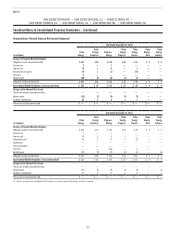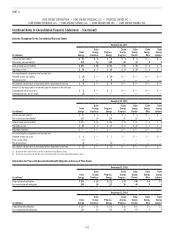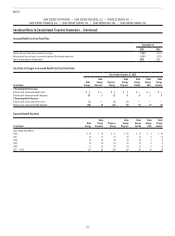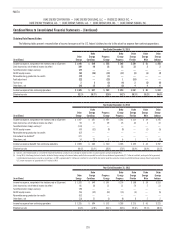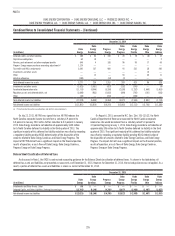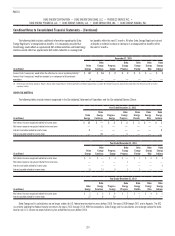Duke Energy 2015 Annual Report Download - page 219
Download and view the complete annual report
Please find page 219 of the 2015 Duke Energy annual report below. You can navigate through the pages in the report by either clicking on the pages listed below, or by using the keyword search tool below to find specific information within the annual report.
199
PART II
DUKE ENERGY CORPORATION • DUKE ENERGY CAROLINAS, LLC • PROGRESS ENERGY, INC. •
DUKE ENERGY PROGRESS, LLC. • DUKE ENERGY FLORIDA, LLC. • DUKE ENERGY OHIO, INC. • DUKE ENERGY INDIANA, INC.
Combined Notes to Consolidated Financial Statements – (Continued)
Fair Value Measurements
Duke Energy classifies recurring and non-recurring fair value
measurements based on the fair value hierarchy as discussed in Note 16.
Valuation methods of the primary fair value measurements disclosed
below are as follows:
Investments in equity securities
Investments in equity securities are typically valued at the closing price
in the principal active market as of the last business day of the reporting
period. Principal active markets for equity prices include published exchanges
such as NASDAQ and NYSE. Foreign equity prices are translated from their
trading currency using the currency exchange rate in effect at the close of the
principal active market. Prices have not been adjusted to reflect after-hours
market activity. The majority of investments in equity securities are valued using
Level 1 measurements. When the price of an institutional commingled fund is
unpublished, it is not categorized in the fair value hierarchy, even though the
funds are readily available at the fair value.
Investments in corporate debt securities and U.S. government securities
Most debt investments are valued based on a calculation using interest
rate curves and credit spreads applied to the terms of the debt instrument
(maturity and coupon interest rate) and consider the counterparty credit rating.
Most debt valuations are Level 2 measurements. If the market for a particular
fixed income security is relatively inactive or illiquid, the measurement is
Level 3. U.S. Treasury debt is typically Level 2.
Investments in short-term investment funds
Investments in short-term investment funds are valued at the net asset
value of units held at year end and are readily redeemable at the measurement
date. Investments in short-term investment funds with published prices
are valued as Level 1. Investments in short-term investment funds with
unpublished prices are valued as Level 2.
Investments in real estate limited partnerships
Investments in real estate limited partnerships are valued by the trustee
at each valuation date (monthly). As part of the trustee’s valuation process,
properties are externally appraised generally on an annual basis, conducted
by reputable, independent appraisal firms, and signed by appraisers that are
members of the Appraisal Institute, with the professional designation MAI. Fair
value is defined as the price that would be received to sell an asset or paid to
transfer a liability in an orderly transaction between market participants at the
measurement date. There are three valuation techniques that can be used to
value investments in real estate assets: the market, income or cost approach.
The appropriateness of each valuation technique depends on the type of
asset or business being valued. In addition, the trustee may cause additional
appraisals to be performed as warranted by specific asset or market conditions.
Property valuations and the salient valuation-sensitive assumptions of each
direct investment property are reviewed by the trustee quarterly and values
are adjusted if there has been a significant change in circumstances related to
the investment property since the last valuation. Value adjustments for interim
capital expenditures are only recognized to the extent that the valuation process
acknowledges a corresponding increase in fair value. An independent firm is
hired to review and approve quarterly direct real estate valuations. Key inputs
and assumptions used to determine fair value includes among others, rental
revenue and expense amounts and related revenue and expense growth rates,
terminal capitalization rates and discount rates. Development investments
are valued using cost incurred to date as a primary input until substantive
progress is achieved in terms of mitigating construction and leasing risk at
which point a discounted cash flow approach is more heavily weighted. Key
inputs and assumptions in addition to those noted above used to determine
the fair value of development investments include construction costs, and the
status of construction completion and leasing. Investments in real estate limited
partnerships are valued at net asset value of units held at year end and are not
readily redeemable at the measurement date. Investments in real estate limited
partnerships are not categorized within the fair value hierarchy.
Duke Energy Master Retirement Trust
The following tables provide the fair value measurement amounts for the Duke Energy Master Retirement Trust qualified pension and other post-retirement assets.
December 31, 2015
(in millions) Total Fair Value Level 1 Level 2 Level 3
Not
Categorized(b)
Equity securities $2,160 $1,470 $ 2 $ — $ 688
Corporate debt securities 4,362 — 4,362 — —
Short-term investment funds 404 192 212 — —
Partnership interests 185 — — — 185
Hedge funds 210 — — — 210
Real estate limited partnerships 118 — — — 118
U.S. government securities 748 — 748 — —
Guaranteed investment contracts 31 — — 31 —
Governments bonds – foreign 34 — 34 — —
Cash 10 10 — — —
Government and commercial mortgage backed securities 9 — 9 — —
Net pending transactions and other investments (28) (36) 8 — —
Total assets(a) $8,243 $1,636 $5,375 $ 31 $ 1,201
(a) Duke Energy Carolinas, Progress Energy, Duke Energy Progress, Duke Energy Florida, Duke Energy Ohio and Duke Energy Indiana were allocated approximately 28 percent, 32 percent, 15 percent, 16 percent, 5 percent and
8 percent, respectively, of the Duke Energy Master Retirement Trust assets at December 31, 2015. Accordingly, all amounts included in the table above are allocable to the Subsidiary Registrants using these percentages.
(b) Certain investments are not categorized. These investments are measured based on the fair value of the underlying investments but may not be readily redeemable at that fair value.




